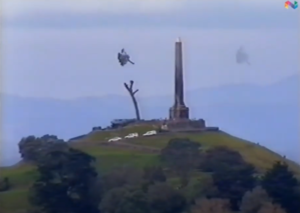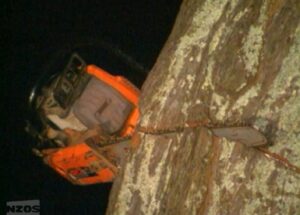1994: Attack on One Tree Hill
October 28, 2024
By AHNZ

One Tree Hill (aka Maungakiekie) is the most Anarchist of Auckland’s volcanic cones as you can tell from the name. By the time The State came along to claim its third capital (Sydney, Old Russell, Auckland, Wellington) it was too late to re-name it after William Hobson or anyone in his sovereignty start-up enterprise. But for that grand one tree, “Maungakiekie would have become Mount Shortland, Mount Felton, or Mathew, or Mount Brown, Jones, or Robinson: heaven knows which but from which we have been defended.” Ref. Daily Southern Cross (1875)
A name picked out by the folk voluntarily and by common use not the government by edict.
As Auckland Skytower can now be seen for many miles around, the lone tree marked out One Tree Hill as the beacon for people, and ship’s captains, to know their way around for generations before. This became especially so when the Father of Auckland, Logan Campbell, now dead and buried on the same hill, finally had his wish granted of the great obelisk to the Maori people erected (1948.)
When the Crown Colony of New Zealand got started there was one massive old pohutukawa atop the hill, hollow and rotting. This was taken for firewood in 1852 which, though probably justified, was cursed decades later as the act of “some Goth” by the Daily Southern Cross which wished sappy nightmares upon the axeman.
Long before the pohutukawa and before the local tribesmen Ngati Awa quit Auckland for Taranaki (a remnant of which got wealthy selling Auckland to Hobson’s people) there was another One Tree legend.
According to the myth, a prior name (and prior tribe or even culture) for Maungakiekie was Te-totara-a-ahua, which means “totara which stands alone.” According to this tradition the One Tree was spawn near the end of the 1500s from a sharp stick touched by umbilical blood. This myth touched two men in very different ways. Logan Campbell in the 1870s set out to restore the namesake tree, Mike Smith in the 1990s set out to bring it down.
Campbell, not having access to magic blood sticks, strove very hard to raise up a totara upon the inhospitable hilltop. According to Brian Rudman in 2013 Auckland Council costed preparing the ground (only removing the old tree) at $564,000. “Councillors were told a replacement tree or trees would cost a minimum of $40,000 a year to tend and protect – a total of $800,000 over 20 years.” This goes to show the expense and effort Campbell set his mind to from 1875 when he took up the lease and resolved to bring back the One Tree. After generations of carrying out his project no totaras survived, only the shelter pines put there to protect them. Until c.1962 there were just 2 remaining and then just the one.¹ And so it remained until 1994.
Enter Mike Smith, part-Maori through his Nga Puhi father, high on myths. For one thing, he had heard from elderly Maori activist Eva Rickard the old legend of the magic totara tree 500 years ago. According to this shaky, unstudied, version it was thought that this tree might have still been alive until Colonial times. And, since totaras can live hundreds of years after all, might have been the one cut down in 1852. Though both activists were outsiders to Auckland it was thought a good idea to go and “help” by an act of brutal vandalism upon Logan Campbell’s tree.
The other myth Smith imbibed is the so-called Declaration of the Independence. Really just some fast leg work in 1835 by James Busby to fend off Baron de Thierry as the two tried to pick up the unclaimed sovereignty they thought was laying out on the street. However, Maoris from Northland in particular (eg Nga Puhi) have come to believe in the document as if gave them special legal rights above other New Zealanders. What these rights are isn’t clear but apparently include the right to remove hill-top city trees.
Smith picked the anniversary of Busby’s Declaration, 28 October, 1994, to make an early morning cut into Auckland’s beloved living heritage. A second attack in October 2000 by the Smith family left the tree unable to recover. It was removed by helicopter on 26 October, 2000. Ref. Three News, geoffmackley, Youtube (2020)
“..in the olden days, as you travelled facting north, One-Tree Hill was the landmark which enabled you to individualise all the other volcanic hills.” – Daily Southern Cross
“It was planted on the summit by Sir John in 1875 as one of five Monterey pine (Pinus radiata) saplings as shelter from the harsh winds around young native trees (including tōtara saplings). The Monterey pine saplings were the only trees to survive. In 1962 all but one pine was left standing and became the famous One Tree Hill pine.” – Cornwall Park, Facebook (2020)
“The accepted tradition that a sacred totara crowned the summit of One Tree Hill before the lone Monterey pine is a myth.” – NZ Herald (2000)
“Historically, the hill was known as Te-totara-a-ahu or “The totara that stands alone.” This was in honour of a totara stick used in the cutting of the umbilical of a high-born boy. Legend says when planted atop the buried placenta it grew into a sacred landmark. That was around 1600.” – NZ Herald (2013)
“..Logan Campbell obtained, in 1875, a fourteen-year lease of the Crown Reserve (which took in the volcanic cone), he immediately decided, in the words of the clipping cited above, to attempt ‘once again to convert Maungakiekie into One Tree Hill’ by planting a tree on the summit.” – Tamaki-Makau-Rau to Auckland, Russell Stone (2001)
“The tree on Auckland’s One Tree Hill is damaged by a chainsaw attack made by a Maori activist who sees it as a symbol of colonial oppression. There is a chance it will survive.” – Holmes (1994,) Auckland University

For an encore, in January 2007, Smith listed the infamous chainsaw on Trade Me for $5,000 reserve. In outrage, it was de-listed but the Museum of New Zealand purchased (for how much?) in 2009 and added it to their collection. Mike Smith has done very well for himself and his cause off the back of his act of vandalism. Rather than be condemned he tends to be congratulated or supported by the mainstream media as well as the State museum.
“In 2000 the damaged pine, which had been kept alive by arborists, was attacked for the final time, reportedly by Smith’s relatives.” – Museum of New Zealand
“I was there with quite a few others the day the last one was chopped up and taken away. We all cried. It felt like a death. I had walked in that park for so many years.” – Comment to Cornwall Park, Facebook (2020)
“Remember the day so clearly when it was cut down-the radio kept playing U2 ‘s One Tree Hill- such a sad day” – ibid
“Maori activists have been blamed for desecrating the grave of Auckland’s Founding Father, John Logan Campbell and smearing slogans over the One Tree Hill obelisk.” – 3 National News and One Network News (28/1/1990)
“He said looking back it probably was not the best attempt to launch the campaign against the fiscal envelope as the message was muddled…He had heard stories from some about what the tree meant to them including the place where some courted or others who had spread loved one’s ashes. He said he had got no comfort from that at all.” – RNZ (2015)
In the 2020s Mike Smith has gone on to attack more New Zealand institutions (eg Fonterra, Z Energy and Genesis) but by lawful means. He has persuaded the Supreme Court to open the flood gates for hundreds of hours of highly paid and prestige-laced work to themselves and many firms full of lawyers. Supposedly the now tattoo-faced man is going to fix Climate Change but I rather suspect he has only created a pretense for lawyers and judges to do what they wanted to do anyway; Extort and parade. Ref. Newshub (2024)
As for the Museum of New Zealand, aka Te Papa, they’ve come even further when it comes to supporting the proceeds of crime than buying one power tool. Maori Activists in 2023 vandalised the giant English version of the Treaty of Waitangi hanging suspended at the museum with an angle grinder and spray paint. The Musuem then collaborated with the vandalism by continuing to display it into late April 2024. Then, after the Arts, Culture, and Heritage Minister Paul Goldsmith had prompted it, they moved the panel away out of sight to store it away like Smith’s chainsaw. Ref. NZ Herald (2024)
The clear lesson seems to be that vandalism and crime is they way to solve complex social problems.
Logan Campbell, like his pine, were famous protectors of Maoris. Their lives were dedicated to helping rather than hurting. It’s certainly not the tree’s fault that the native it was put there to protect couldn’t endure. Smith’s hate crime, along with being misinformed about history, was the biting of the hand reaching out to help. It’s the same now as he tries to take a chainsaw to the businesses that pay New Zealand’s taxes. If Maoris who cannot endure do keep trying to take out their failures on the productive for trying to help them how much longer will this be tolerated? Eventually some vandals will break too much and hurt too many innocent people. The benevolence will be cut off. The hate will be reciprocated.
—
1 Ref. Or 1960. Blog Eight (2007)
Image ref. Dying tree dismembered, 2000. Three News (2000)
Image ref. One Tree Hill, Early 90s. Garry Lawrence. Reddit (2023)
 Like Comment Share
Like Comment Share





